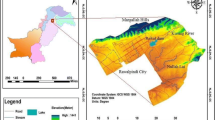Abstract
This study presents a methodology for siting municipal solid waste landfills, coupling geographic information systems (GIS), fuzzy logic, and multicriteria evaluation techniques. Both exclusionary and non-exclusionary criteria are used. Factors, i.e., non-exclusionary criteria, are divided in two distinct groups which do not have the same level of trade off. The first group comprises factors related to the physical environment, which cannot be expressed in terms of monetary cost and, therefore, they do not easily trade off. The second group includes those factors related to human activities, i.e., socioeconomic factors, which can be expressed as financial cost, thus showing a high level of trade off. GIS are used for geographic data acquisition and processing. The analytical hierarchy process (AHP) is the multicriteria evaluation technique used, enhanced with fuzzy factor standardization. Besides assigning weights to factors through the AHP, control over the level of risk and trade off in the siting process is achieved through a second set of weights, i.e., order weights, applied to factors in each factor group, on a pixel-by-pixel basis, thus taking into account the local site characteristics. The method has been applied to Evros prefecture (NE Greece), an area of approximately 4,000 km2. The siting methodology results in two intermediate suitability maps, one related to environmental and the other to socioeconomic criteria. Combination of the two intermediate maps results in the final composite suitability map for landfill siting.






Similar content being viewed by others
References
Aivaliotis V, Dokas I, Hatzigiannakou M, Panagiotakopoulos D (2004) Functional relationships of landfill and landraise capacity with design and operation parameters. Waste Manag Res 22:283–290
Al-Jarrah O, Abu-Qdais H (2005) Municipal solid waste landfill siting using intelligent system. Waste Manag 26:299–306
Bagchi A (1990) Design, construction and monitoring of sanitary landfill. Wiley, New York, pp. 235–245
Charnpratheep K, Zhou Q, Garner B (1997) Preliminary landfill site screening using fuzzy geographical information systems. Waste Manag Res 15:197–215
Dafis S, Papastergiadou E, Georgiou K, Babalonas D, Georgiadis T, Papageorgiou M, Lazaridou T, Tsiaoussi V (1997) Directive 92/43/EEC: the Project Habitat in Greece: Network Natura 2000, Life Contract B4-3200/84/756, DG XI Commission of the European Communities, the Goulandris Mouseum of Natural History, Greek Biotope/Wetland Center, Greece (in Greek)
Eastman JR (2003) IDRISI Kilimanjaro: guide to GIS and image processing. Clark Laboratories, Clark University, Worcester, pp 328
Eastman JR, Jiang H (1996) Fuzzy measures in multi-criteria evaluation. Paper presented at the 2nd international symposium on spatial accuracy assessment in natural resources and environmental studies, Fort Collins, 21–23 May 1996, pp. 527–534
European Compost Network (2004) http://www.compostnetwork.info. Cited 15 November 2005
Gemitzi A, Petalas C, Tsihrintzis VA, Pisinaras V (2006) Assessment of groundwater vulnerability to pollution: a combination of GIS, fuzzy logic and decision making techniques. Environ Geol 49:653–673
Geoinfo Co. (1998) Digital Data for Greece—GR Survey Data Base
Greek Governmental Ministry Decision 114218/97 (1997) Document 1016 B’/17-11-1997 “Framework of specifications and general planning for the management of solid wastes” (in Greek)
Gupta R, Kewalramaniz MA, Ralegaonkar RV (2003) Environmental impact analysis using fuzzy relation for landfill siting. J Urban Plan Dev 129:121–139
Jenson SK, Domingue JO (1998) Extracting topographic structure from digital elevation data for geographic information systems analysis. Photogrammetric Eng Remote Sens 54:1593–1600
Kao JJ, Lin HY (1996) Multifactor spatial analysis for landfill siting. J Environ Eng 122:902–908
Kontos TD, Komilis DP, Halvadakis CP (2003) Siting MSW landfills on Lesvos island with a GIS-based methodology. Waste Manag Res 21:262–278
Lin H, Kao J (1998) Enhanced spatial model for landfill siting analysis. J Environ Eng 125:845–851
Lukasheh AF, Droste RL, Warith MA (2001) Review of expert system (ES), geographical information system (GIS), decision support system (DSS) and their application in landfill design and management. Waste Manag Res 19:177–185
Nemani RR, Keeling CD, Hashimoto H, Jolly WM, Piper SC, Tucker CJ, Myneni RB, Running SW (2003) Climate-driven increases in global terrestrial net primary production from 1982 to 1999. Science 300:1560–1563
Northwood Technologies Inc. and Malconi Mobile Ltd (2001) Vertical Mapper spatial analysis and display software, version 3.1, User’s Manual, 369 pp
OASP (2004) Earthquake planning and protection organization http://www.oasp.gr
Pavlikakis GE, Tsihrintzis VA (2003) A quantitative method for accounting human opinion, preferences and perceptions in ecosystem management. J Environ Manag 68:193–205
Rao M, Sastry SVC, Yadar PD, Kharod K, Pathan SK, Dhinwa PS, Majumdar PS, Sampat Kumar D, Patkar VN, Phatak VK (1991) A weighted index model for urban suitability assessment—a GIS approach. Bombay Metropolitan Regional Development Authority, Bombay, India
Saaty TL (1977) A scaling method for priorities in hierarchical structures. J Math Psychol 15:234–281
Sener B, Süzen ML, Doyuran V (2006) Landfill site selection by using geographic information systems. Environ Geol 49:376–388
Siddiqui M, Everett JM, Vieux BE (1996) Landfill siting using geographical information systems: a demonstration. J Environ Eng 122:515–523
Voogd H (1983) Multicriteria evaluation for urban and regional planning. Pion, London
Yager R (1988) On ordered weighted averaging aggregation operators in multicriteria decision making. IEEE Trans Syst Man Cybern 8:183–190
Acknowledgments
The first author gratefully acknowledges the Regional Authority of Eastern Macedonia and Thrace for its support during the time needed for the completion of this study.
Author information
Authors and Affiliations
Corresponding author
Rights and permissions
About this article
Cite this article
Gemitzi, A., Tsihrintzis, V.A., Voudrias, E. et al. Combining geographic information system, multicriteria evaluation techniques and fuzzy logic in siting MSW landfills. Environ Geol 51, 797–811 (2007). https://doi.org/10.1007/s00254-006-0359-1
Received:
Accepted:
Published:
Issue Date:
DOI: https://doi.org/10.1007/s00254-006-0359-1




